|
 |
| Adult, Santa Cruz County |
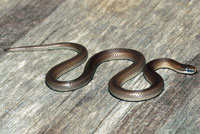 |
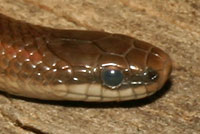 |
 |
| Adult, Santa Cruz County |
Adult in shed, Santa Cruz County |
Adult, Santa Cruz County |
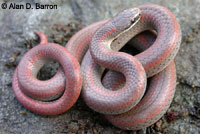 |
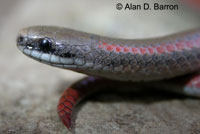 |
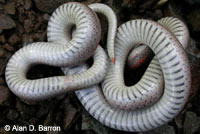 |
| Adult, Del Norte County © Alan D. Barron |
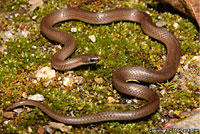 |
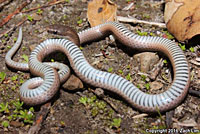 |
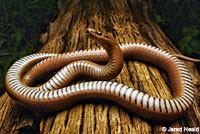 |
| Adult, Santa Cruz County © Zachary Lim |
Adult, San Mateo County © Jared Heald |
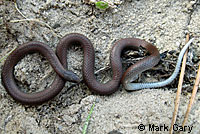 |
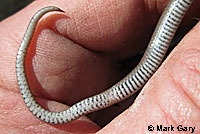 |
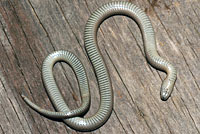 |
| Adult, Santa Cruz County © Mark Gary |
Underside of adult, Santa Cruz County |
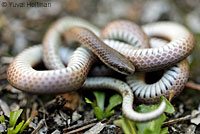 |
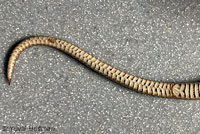 |
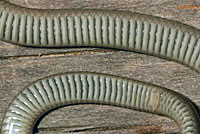 |
| Adult, San Mateo County © Yuval Helfman |
Underside of adult, Santa Cruz County |
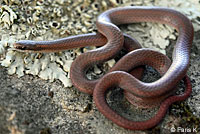 |
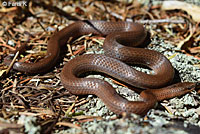 |
|
| Adult, Santa Cruz County © Faris K |
Adult, Santa Cruz County © Faris K |
|
| |
|
|
| Habitat |
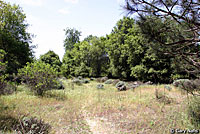 |
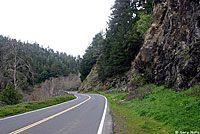 |
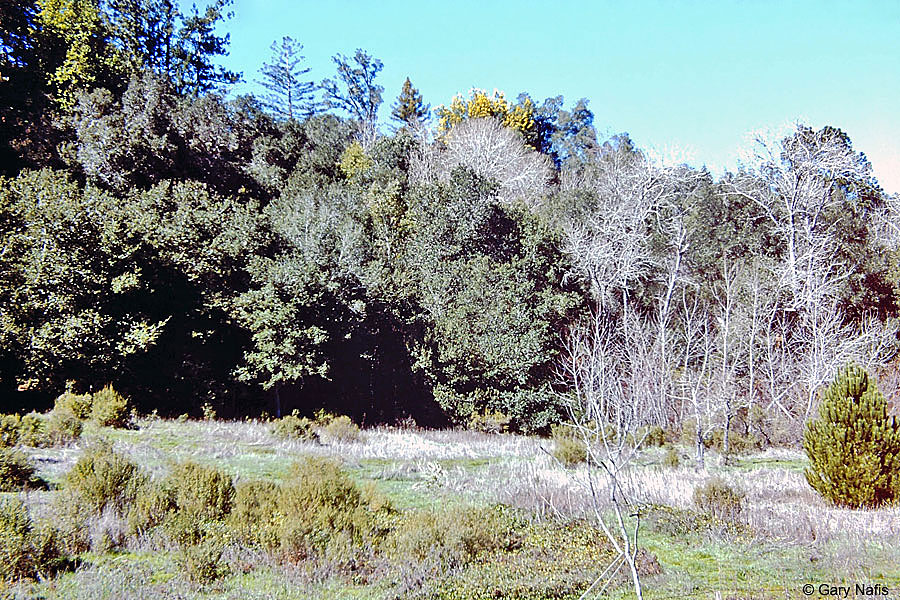 |
| Habitat, Santa Cruz County |
Habitat, Mendocino County |
Habitat, Santa Cruz County
|
| |
|
|
Comparisons of the Two Species of Sharp-tailed Snakes (Contia) |
Below:
C. longicauda from Santa Cruz County
C. tenuis from Santa Clara County.
|
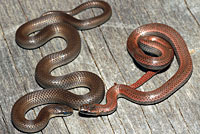 |
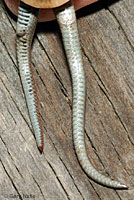 |
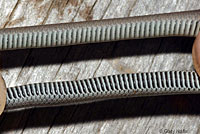 |
C. tenuis on right
C. longicauda on left
(In shed with duller than usual coloring)
|
C. tenuis on the left
C. longicauda on the right
C. longicauda has a longer tail
with more subcaudal scales that
lack black crossbars
|
C. tenuis on bottom
C. longicauda on top
C. tenuis has wider dark crossbars on the ventral scales |
| Identifying the Species |
Subcaudal scale count and tail length
The easiest way to differentiate the two species in the field is to look at the subcaudal scales and the tail length.
(Subcaudal scales are the scales on the tail behind the cloaca.)
C. longicauda has a longer tail with more subcaudal scales than C. tenuis.
C. longicauda has from 43 to 58 subcaudal scales.
C. tenuis has from 42 to 43 subcaudal scales.
The tail of C. longicauda averages 20 percent of the total length of the snake.
The tail of C. tenuis averages 14.5 percent of the total length.
Width of the dark crossbars on the ventral scales
C. longicauda has narrow black crossbars marking the anterior portion of the ventral scales, covering only
1/3 to 1/4 of each ventral scale. The black crossbars are usually absent from the subcaudal scales.
C. tenuis has wider black crossbars on the anterior part of the ventral scales, covering
1/2 to 1/3 of each ventral scale.The black crossbars usually extend onto the subcaudal scales.
C. longicaudae is also larger overall and there are subtle differences in dorsal and ventral coloration and pigmentation, but these probably won't help in identification.
Check the range map - there is little range overlap.
(From Feldman and Hoyer, 2010)
|
|
| Description |
Not Dangerous - This snake does not have venom that can cause death or serious illness or injury in most humans.
Commonly described as "harmless" or "not poisonous" to indicate that its bite is not dangerous, but "not venomous" is more accurate. (A poisonous snake can hurt you if you eat it. A venomous snake can hurt you if it bites you.)
|
| Size |
Adults average 11 inches (27.9 cm) ranging from 4.9 - 17.6 inches in total length (12.4 - 44.7 cm).
Hatchlings are about 3 inches long.
|
| Appearance |
| A small thin snake with a small head and a sharp-ended tail. |
| Color and Pattern |
The head of an adult is typically medium to light olive-gray or brown with black flecking or blotches, occasionally with orange blotches.
Dorsal coloration is rusty, brick-red, or orange-red.
Most adults have either faint or distinctly-colored brick-red or orange-red dorsolateral stripes extending from the head along the front third of the body where they blend into the body color.
Occasionally the reddish coloration and dorsolateral stripes are not present.
The underside is pale with a black mark across the edge of each scale. The black marks becoming faint or absent towards the tail, and absent from the anal plate and the caudal scales.
|
| Young |
Juveniles typically have brighter dorsal coloration than adults.
|
| Life History and Behavior |
Activity |
(Little has been published about this species, so this information comes from descriptions of C. tenuis.)
Sharp-tailed snakes tend to be found most often on sunny days during the rainy season resting under objects in open areas such as boards, rocks, wood debris, gravel piles, or leaf litter.
Secretive, spends much time under surface objects or underground.
A good burrower.
Prefers moist environments.
Active when the ground is damp, occasionally during or after rains, and sometimes when surface temperatures are as low as 50 degrees.
Long teeth allow the snake to hold on to its slippery prey.
|
| Diet and Feeding |
(Little has been published about this species, so this information comes from descriptions of C. tenuis.)
Feeds on slugs and their eggs and on slender salamanders. |
| Reproduction |
(Little has been published about this species, so this information comes from descriptions of C. tenuis.)
Females are oviparous, laying eggs in June or July. Hatchlings emerge in mid-autumn.
|
| Habitat |
Found in well-shaded moist forest habitats dominated by Douglas fir and redwoods. Also found in mixed woodlands with oaks and conifers.
|
| Geographical Range |
The Forest Sharp-tailed Snake "Occurs along the outer Coast Ranges from northern California to southwestern Oregon, the Klamath Mountains of northern California and southern Oregon, and portions of the Cascade Ranges in southern Oregon." (Feldman and Hoyer, 2010.)
In California, specimens have been found in Del Norte, Humboldt, Mendocino, San Mateo, Santa Clara, Santa Cruz, Sonoma, Trinity, and Del Norte counties. The species has not yet been found in Siskiyou, Marin, and most of the coast of Sonoma County, but it is expected to occur there in the more moist well-forested areas.
The Del Norte county snake (shown above) was found in October 2011 by Brad Norman and Alan D. Barron.
(Bradford R. Norman, Alan D. Barron, Chris R. Feldman. Herpetological Review 43(2), 2012.)
Comparison of range and habitat with the Common Sharp-tailed Snake - Contia tenuis
There does not appear to be much overlap in range between C. tenuis and C. longicauda, and they have not yet been found at the same location, but the two species come into close proximity in California in San Mateo and Santa Cruz Counties, in Sonoma and Mendocino Counties, and in Southwestern Oregon. (I have indicated in purple on the range map one area in Sonoma and Mendocino Counties where their distribution may overlap. There could also be other areas of overlap in California, including San Mateo county and the border of Humboldt and Trinity counties.) They appear to be segregated by habitat type in these areas. C. longicauda typically occurs in moist well-forested areas, while C. tenuis occurs in somewhat drier, more open habitats of grassland, mixed woodland, and occasionally chaparral.
|
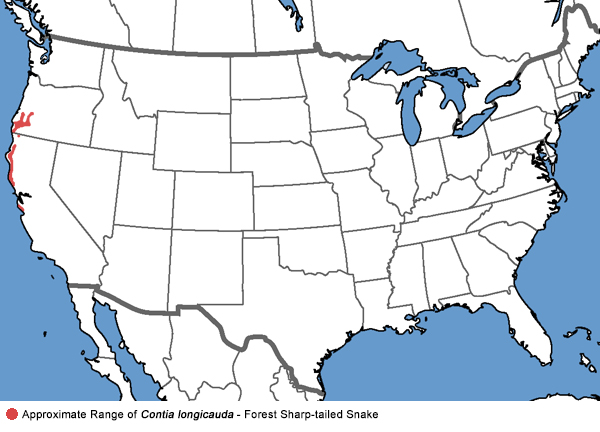 |
| Notes on Taxonomy |
Contia longicauda went unnoticed for a long time because of its similarities to Contia tenuis and because of its small size, fossorial and secretive nature, and seasonally-limited period of activity. The long-recognized Sharp-tailed Snake, Contia tenuis, was found to consist of two species which are almost identical in appearance - Contia tenuis, and a new species, Contia longicauda, which was discovered by Richard Hoyer based on differences in size, scale counts, and habitat preference. DNA evidence was presented by Feldman and Spicer in 2002. (Journal of Herpetology 36(4): 648-655).
A formal description of the new species was published in 2010:
Chris R. Feldman, Richard F. Hoyer A New Species of Snake in the Genus Contia (Squamata: Colubridae) from California and Oregon. Copeia May 2010, Vol. 2010, No. 2 : pp. 254-267.
The Society for the Study of Amphibians and Reptiles
changed the species name longicaudae to longicauda in their 2012 list of scientific and common names:
"This species was originally named Contia longicaudae by Feldman and Hoyer (2010, Copeia, 2010: 254–267); however, because they explicity treated the second part of the binomen as an adjective, it must agree with the name Contia in gender and number so that the correct spelling is Contia longicauda."
Alternate and Previous Names (Synonyms)
Contia longicauda - Forest Sharp-tailed Snake (Stebbins & McGinnis 2012)
Contia tenuis - Sharp-tailed Snake (Stebbins 1954, 1966, 1985, 2003)
Gentle Brown Snake; Oregon Worm Snake; Pacific Brown Snake; Pacific Ground Snake (Wright & Wright 1957)
Contia mitis - Sharp-tailed Snake (Ablabes purpureocauda; Homalosoma mite. Purple-tailed Snake; Pacific Ground Snake; Brown Snake; Gentle Brown Snake) (Grinnell and Camp 1917)
Contia tenuis - Sharp-tailed Snake (Van Denburgh 1897)
Purple-tailed Snake (Yarrow 1882)
|
| Conservation Issues (Conservation Status) |
| None |
|
| Taxonomy |
| Family |
Colubridae |
Colubrids |
Oppel, 1811 |
| Genus |
Contia |
Sharp-tailed Snakes |
Baird and Girard, 1853 |
Species
|
longicauda |
Forest Sharp-tailed Snake |
Feldman and Hoyer, 2010 |
|
Original Description |
Contia longicauda - (Feldman and Hoyer, 2010) Copeia May 2010, Vol. 2010, No. 2 : pp. 254-267
Originally within
(Contia tenuis - (Baird and Girard, 1852) - Proc. Acad. Nat. Sci. Philadelphia, Vol. 6, p. 176)
from Original Description Citations for the Reptiles and Amphibians of North America © Ellin Beltz
|
|
Meaning of the Scientific Name |
Contia - honors Le Conte, John L.
longicauda
- Latin = long-tailed (longi = long and cauda = tail)
Taken partly from Scientific and Common Names of the Reptiles and Amphibians of North America - Explained © Ellin Beltz
|
|
Alternate Names |
Formerly recognized as the species Contia tenuis - (Common) Sharp-tailed Snake
|
|
Related or Similar California Snakes |
Contia tenuis - (Common) Sharp-tailed Snake
Diadophis punctatus - Ring-necked Snake |
|
More Information and References |
California Department of Fish and Wildlife
Chris R. Feldman, Richard F. Hoyer A New Species of Snake in the Genus Contia (Squamata: Colubridae) from California and Oregon. Copeia May 2010, Vol. 2010, No. 2 : pp. 254-267.
Hansen, Robert W. and Shedd, Jackson D. California Amphibians and Reptiles. (Princeton Field Guides.) Princeton University Press, 2025.
Stebbins, Robert C., and McGinnis, Samuel M. Field Guide to Amphibians and Reptiles of California: Revised Edition (California Natural History Guides) University of California Press, 2012.
Stebbins, Robert C. California Amphibians and Reptiles. The University of California Press, 1972.
Flaxington, William C. Amphibians and Reptiles of California: Field Observations, Distribution, and Natural History. Fieldnotes Press, Anaheim, California, 2021.
Samuel M. McGinnis and Robert C. Stebbins. Peterson Field Guide to Western Reptiles & Amphibians. 4th Edition. Houghton Mifflin Harcourt Publishing Company, 2018.
Stebbins, Robert C. A Field Guide to Western Reptiles and Amphibians. 3rd Edition. Houghton Mifflin Company, 2003.
Behler, John L., and F. Wayne King. The Audubon Society Field Guide to North American Reptiles and Amphibians. Alfred A. Knopf, 1992.
Powell, Robert., Joseph T. Collins, and Errol D. Hooper Jr. A Key to Amphibians and Reptiles of the Continental United States and Canada. The University Press of Kansas, 1998.
Bartlett, R. D. & Patricia P. Bartlett. Guide and Reference to the Snakes of Western North America (North of Mexico) and Hawaii. University Press of Florida, 2009.
Bartlett, R. D. & Alan Tennant. Snakes of North America - Western Region. Gulf Publishing Co., 2000.
Brown, Philip R. A Field Guide to Snakes of California. Gulf Publishing Co., 1997.
Ernst, Carl H., Evelyn M. Ernst, & Robert M. Corker. Snakes of the United States and Canada. Smithsonian Institution Press, 2003.
Taylor, Emily. California Snakes and How to Find Them. Heyday, Berkeley, California. 2024.
Wright, Albert Hazen & Anna Allen Wright. Handbook of Snakes of the United States and Canada. Cornell University Press, 1957.
Brown et. al. Reptiles of Washington and Oregon. Seattle Audubon Society,1995.
Nussbaum, R. A., E. D. Brodie Jr., and R. M. Storm. Amphibians and Reptiles of the Pacific Northwest. Moscow,
Idaho: University Press of Idaho, 1983.
St. John, Alan D. Reptiles of the Northwest: Alaska to California; Rockies to the Coast. 2nd Edition - Revised & Updated. Lone Pine Publishing, 2021.
Joseph Grinnell and Charles Lewis Camp. A Distributional List of the Amphibians and Reptiles of California. University of California Publications in Zoology Vol. 17, No. 10, pp. 127-208. July 11, 1917.
|
|
|
The following conservation status listings for this animal are taken from the April 2024 State of California Special Animals List and the April 2024 Federally Listed Endangered and Threatened Animals of California list (unless indicated otherwise below.) Both lists are produced by multiple agencies every year, and sometimes more than once per year, so the conservation status listing information found below might not be from the most recent lists. To make sure you are seeing the most recent listings, go to this California Department of Fish and Wildlife web page where you can search for and download both lists:
https://www.wildlife.ca.gov/Data/CNDDB/Plants-and-Animals.
A detailed explanation of the meaning of the status listing symbols can be found at the beginning of the two lists. For quick reference, I have included them on my Special Status Information page.
If no status is listed here, the animal is not included on either list. This most likely indicates that there are no serious conservation concerns for the animal. To find out more about an animal's status you can also go to the NatureServe and IUCN websites to check their rankings.
Check the current California Department of Fish and Wildlife sport fishing regulations to find out if this animal can be legally pursued and handled or collected with possession of a current fishing license. You can also look at the summary of the sport fishing regulations as they apply only to reptiles and amphibians that has been made for this website.
This snake is not included on the Special Animals List, which indicates that there are no significant conservation concerns for it in California.
|
| Organization |
Status Listing |
Notes |
| NatureServe Global Ranking |
|
|
| NatureServe State Ranking |
|
|
| U.S. Endangered Species Act (ESA) |
None |
|
| California Endangered Species Act (CESA) |
None |
|
| California Department of Fish and Wildlife |
None |
|
| Bureau of Land Management |
None |
|
| USDA Forest Service |
None |
|
| IUCN |
|
|
|
|



























